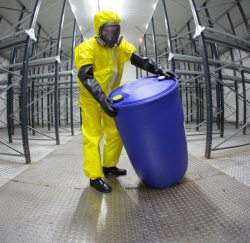Handling Hazardous Materials
The handling of hazardous substance-containing drums and containers presents a variety of potential health and safety hazards to employees such as fires/explosions, vapor generation, and physical injury caused by moving heavy containers by hand.
Employers must ensure appropriate methods, procedures, and equipment are in place that address at least the following:
- drums and containers used during the cleanup must meet the required OSHA, EPA (40 CFR Parts 264-265 and 300), and Department of Transportation (DOT) regulations (49 CFR Parts 171-178), and must be properly inspected and labeled,
- damaged drums or containers that may rupture or spill when moved must be emptied of their contents using a device classified for the material being transferred, and must be properly discarded,
- in areas where spills, leaks, or ruptures may occur, the employer must furnish employees with salvage drums or containers, an adequate quantity of absorbent material, and approved fire-extinguishing equipment in the event of small fires,
- the employer must inform employees of the appropriate hazard warnings for labeled drums, the removal of soil or coverings, and the dangers of handling unlabeled drums or containers without prior identification of their contents,
- to the extent feasible, the moving of drums or containers must be kept to a minimum, and a program must be implemented to contain and isolate hazardous substances being transferred into drums or containers, and
- ground penetrating systems or other detection devices must be used to estimate the location and depth of buried drums and containers.
The employer also must ensure safe work practices are instituted before opening a drum or container. For example:
- Air-line respirators and approved electrical equipment must be protected from possible contamination, and all equipment must be kept behind any existing explosion barrier.
- A physical barricade, natural or man-made that has been designed and constructed of sufficient thickness and density to withstand or deflect the impact loads of an adjacent explosion.
- Only tools or equipment that prevent ignition must be used.
- All employees not performing the operation must be located at a safe distance and behind a suitable barrier to protect them from accidental explosions.
- Also, standing on or working from drums or containers is prohibited.
Special care also must be taken when an employee handles containers of shock-sensitive waste, explosive materials, or laboratory waste packs. When shock-sensitive wastes are handled, the employer must ensure the following:
- Evacuate non-essential employees from the transfer area.
- Protect equipment operators from exploding containers by using a barrier.
- Make available a continuous means of communication (e.g., suitable radios or telephones), and a distinguishable and distinct alarm system to signal the beginning and end of activities where explosive wastes are handled.
- If drums or containers bulge or swell or show crystalline material on the outside, they must not be moved onto or from the site unless appropriate containment procedures have been implemented.
- Lab packs must be opened only when necessary and only by a qualified person.
- Before shipment to a licensed disposal facility, all drums or containers must be properly labeled and packaged for shipment.
- Staging areas also must be kept to a minimum and provided with adequate access and exit routes.
Knowledge Check Choose the best answer for the question.
3-5. Manuel is moving a hazardous substance-containing drum by hand. What hazard should Manuel be aware of before moving the drum?
You forgot to answer the question!

